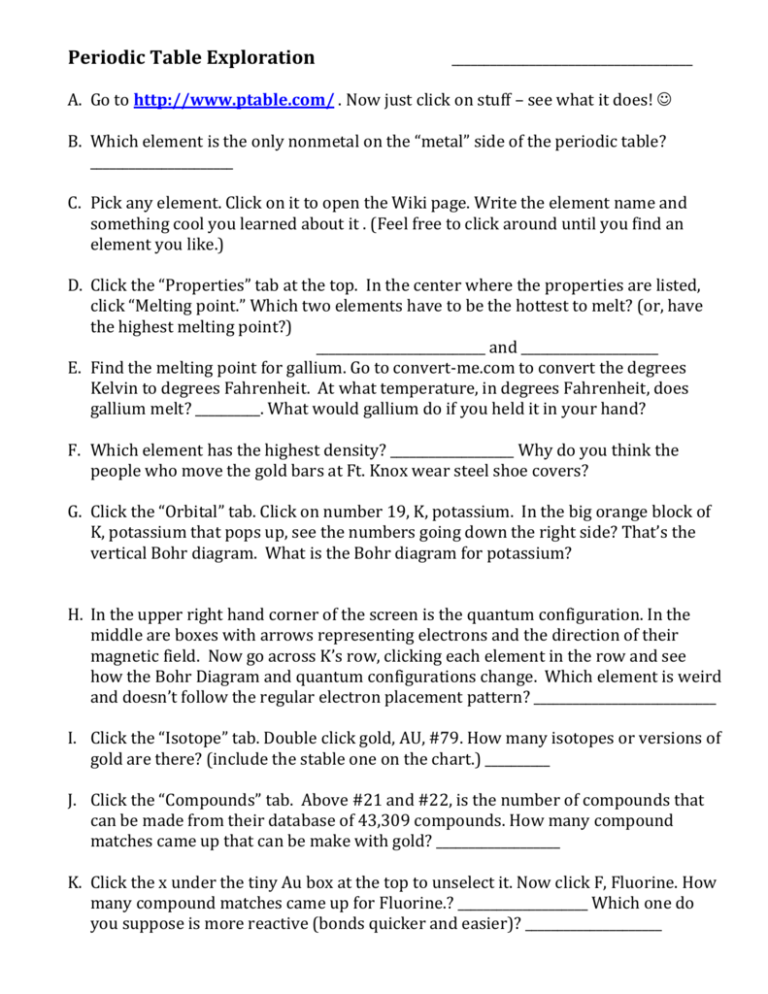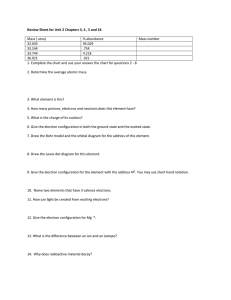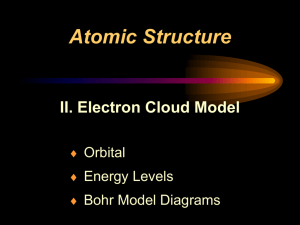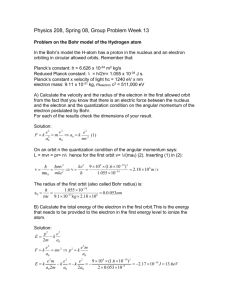Periodic Table Internet Exploration and Coloring
advertisement

Periodic Table Exploration _____________________________________ A. Go to http://www.ptable.com/ . Now just click on stuff – see what it does! B. Which element is the only nonmetal on the “metal” side of the periodic table? ______________________ C. Pick any element. Click on it to open the Wiki page. Write the element name and something cool you learned about it . (Feel free to click around until you find an element you like.) D. Click the “Properties” tab at the top. In the center where the properties are listed, click “Melting point.” Which two elements have to be the hottest to melt? (or, have the highest melting point?) __________________________ and _____________________ E. Find the melting point for gallium. Go to convert-me.com to convert the degrees Kelvin to degrees Fahrenheit. At what temperature, in degrees Fahrenheit, does gallium melt? __________. What would gallium do if you held it in your hand? F. Which element has the highest density? ___________________ Why do you think the people who move the gold bars at Ft. Knox wear steel shoe covers? G. Click the “Orbital” tab. Click on number 19, K, potassium. In the big orange block of K, potassium that pops up, see the numbers going down the right side? That’s the vertical Bohr diagram. What is the Bohr diagram for potassium? H. In the upper right hand corner of the screen is the quantum configuration. In the middle are boxes with arrows representing electrons and the direction of their magnetic field. Now go across K’s row, clicking each element in the row and see how the Bohr Diagram and quantum configurations change. Which element is weird and doesn’t follow the regular electron placement pattern? ____________________________ I. Click the “Isotope” tab. Double click gold, AU, #79. How many isotopes or versions of gold are there? (include the stable one on the chart.) __________ J. Click the “Compounds” tab. Above #21 and #22, is the number of compounds that can be made from their database of 43,309 compounds. How many compound matches came up that can be make with gold? ___________________ K. Click the x under the tiny Au box at the top to unselect it. Now click F, Fluorine. How many compound matches came up for Fluorine.? ____________________ Which one do you suppose is more reactive (bonds quicker and easier)? _____________________ 1. Go to http://www.periodictable.com/ Ooohhh, cooool. Look at the pretty pictures. 2. Click on Polonium, #84 3. Click on the blue words on the right, “Technical data.” 4. When was it discovered and where? __________________________ 5. Most of the information that could be listed is marked as “NA” (not applicable) because it is radioactive and breaks down fairly quickly. Still, scroll down and write one fact you found about Polonium. ________________________________________________________ 6. Click back to the prior page. 7. Scroll down until you find the picture of the Lone Ranger Spinthariscope 8. Under the picture, click the “spin” link. Okay, that’s cool. (Well, it is on my computer. If it doesn’t show you a video of the ring spinning, we’ll blame the chromebooks.) 9. Now go back and read about what this object is. 10. A) Was this object sold when it was radioactive? _______ B) How could you get one of these objects? ___________________________________________________________________ C) What age group of people would have probably purchased these? _____________________________________________________________________ WHAT WHERE THOSE WACKY GUYS IN MARKETING THINKING!!!? 11. Now that you see how this periodic table works, pick your choice: one metal _____________________ one transition metal _____________________ one metalloid _____________________ one nonmetal _____________________ a radioactive element you have not already done _____________________ ……and one element that is YOUR PERSONAL ELEMENT. _________________________ (For some reason, this element calls to you from the table and has bonded emotionally with you.) For your personal element find out: 1. the atomic number, atomic mass, number of neutrons, family, and period. 2. electron configuration (You may see something like [Kr]5s2. That means, I’m too lazy to write out the whole long thing, so just take the electron configuration of Krypton, Kr, and add 5s2 to it.) 3. Its phase (solid, liquid, gas, plasma, Bose-Einstein condensate) 4. Density (a low number here and your element would be not tightly packed, like Styrofoam; a high number would make it like lead.) 5. Specific heat (a low number here means it gets hot quickly, a big number means it takes forever to heat up) 6. Under “Abundance,” it makes up what % of the universe, the earth, and you? 7. Under “Atomic Dimensions and Structure, what is your atom’s radius in pm (picometers – a trillionth of a meter, 1 x 10-12 meters, or a millionth of a micron, or a hundredth of an Angstrom. Really small. Just for kicks you can convert your answer to meters at convert-me.com. ) 8. Your narrative. Describe what is unusual, appealing, or interesting about your chosen element. Five sentences minimum. Extra points if you can do it as a Haiku, limerick, or other form of poetry. Notes and Coloring (See ppt) Main Ideas 1. The current PT has the elements in order of increasing ___________________________. 2. The elements were first put in order of increasing _________________________, but that made the columns not line up well. (Not all the elements behaved the same.) 3. Metals are on the ______________________.* 4. Metals are…… 5. Nonmetals are on the ___________________________** 6. Nonmetals are…. 7. Metalloids are on the _______________________________ 8. Metalloids are…. 9. Elements in the same column (group) have similar __________________________. This is because all elements in the same column have the same number of __________________ electrons.*** 10. Elements in the same row (period) have the same number of electron levels. 11. Elements 1-92 are naturally occurring.**** 12. The most reactive elements on the PT are in the ________________ _________________ and ___________________ ___________________ corners***** 13. Noble gas do not __________________****** The Exceptions…. * Except the lanthinides and actinides. They’re the metals at the bottom. **Except Hydrogen. He has properties of columns 1 & 17 so he just floats above the PT. ***Except Helium. But his electron level is full like all the other elements in his column. **** Except Technetium (43) and Promethium (61) are so incredibly rare most all atoms of them are synthesized. *****Except noble gases generally don’t react so really, it’s one column in from the corner. On the other side, Francium is very radioactive and decays down to half its mass every 22 minutes., vaporizing any visible amount. ******Except in the lab, we’ve been able to force Xenon to bond with fluorine.




